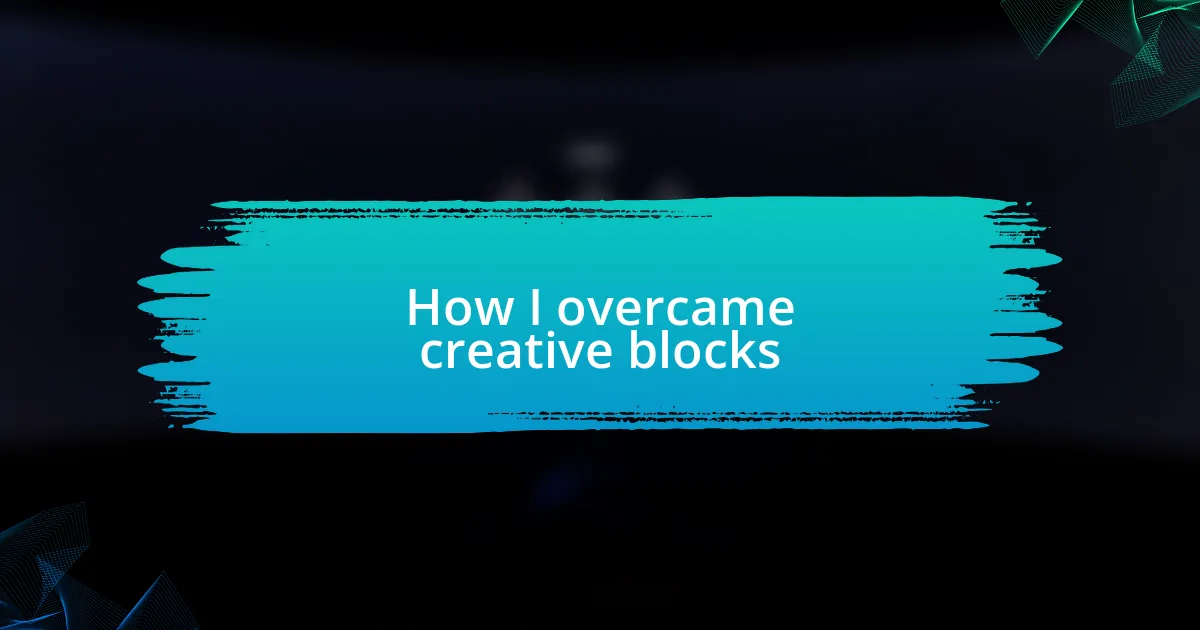Key takeaways:
- Creative blocks often stem from emotional states, perfectionism, stress, and external pressures.
- Identifying the root causes of creative blocks is crucial for overcoming them and restoring motivation.
- Techniques such as changing environments, freewriting, and collaborating can effectively spark creativity.
- Establishing daily habits and rituals can nurture creativity and maintain a steady flow of ideas.
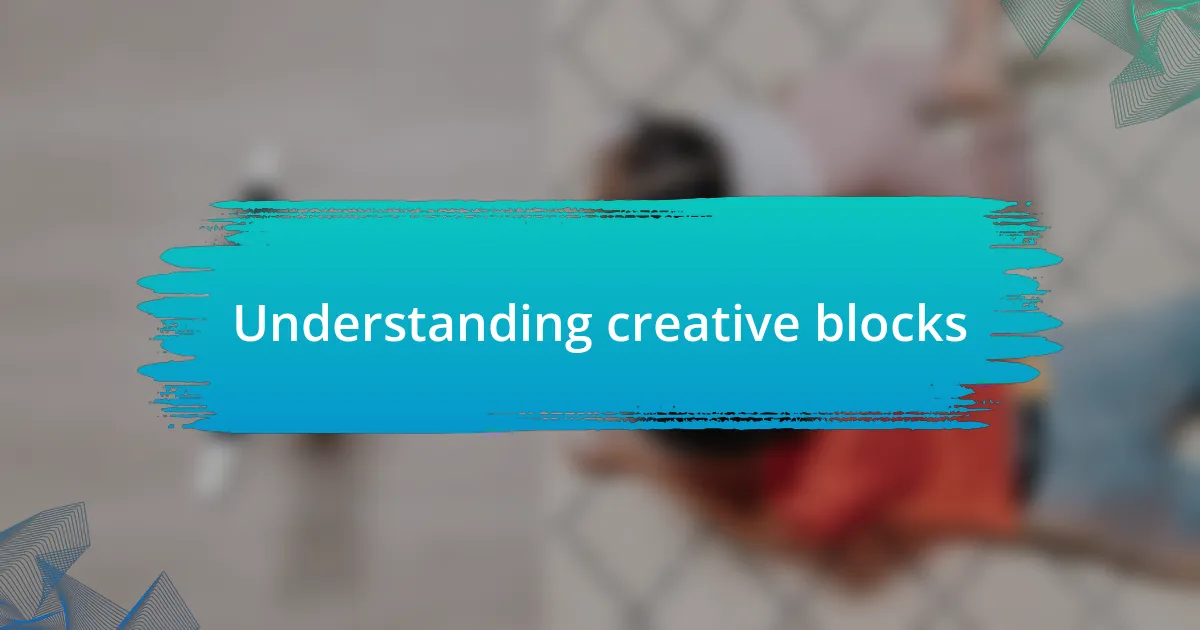
Understanding creative blocks
Creative blocks can feel like an insurmountable wall when you’re in the thick of it. I remember a time when I sat at my desk, staring at a blank page, completely paralyzed by self-doubt. Did I lose my touch, or was I simply overthinking every word? These moments are frustrating, and it’s essential to recognize that they can stem from a variety of sources—stress, perfectionism, or even external pressures.
When I delve into the root causes of my own creative blocks, I often find they’re tied to my emotional state. I once let the fear of criticism hold me back from sharing a project I was passionate about. How many of us have experienced that same fear? It’s crucial to acknowledge that these feelings are not just part of the creative process; they’re part of being human.
Understanding creative blocks is also about recognizing the cyclical nature of inspiration. There are periods when ideas flow effortlessly and others when they seem impossible to grasp. Reflecting on my experiences, I’ve learned to embrace these ebbs and flows, realizing that creating is inherently messy. Could it be that the struggle itself is a necessary step toward growth and innovation?
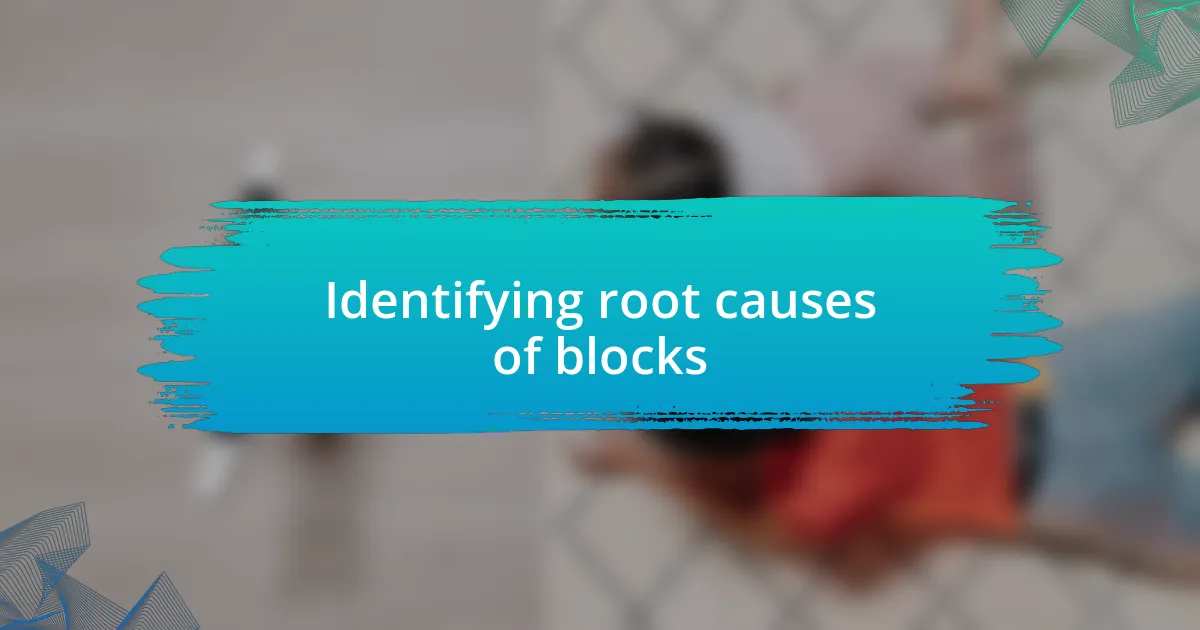
Identifying root causes of blocks
Identifying the root causes of creative blocks is essential for overcoming them. From my own experience, I’ve discovered that my blocks often arise from a discrepancy between my expectations and reality. There was a time when I aimed for perfection in every project, which only led to paralyzing self-doubt. Recognizing that this pressure stems from my desire to succeed helped me to alleviate some of the weight I placed on my shoulders.
Emotional triggers play a significant role in creative blocks as well. I recall a particularly stressful period at work when I felt overwhelmed by the demands piling up. During that time, I couldn’t find the motivation to create anything meaningful. Once I identified that stress as the root cause, I took small steps to restore balance in my life, such as meditation and taking breaks. Acknowledging these emotional elements is fundamental to breaking through the creative fog.
It’s fascinating how external factors can also contribute to creative blocks. I once had a mentor who was very critical of my work, and the pressure to impress her made me hesitant to pursue my ideas. When I realized that this external influence was stifling my creativity, I took a step back and focused on my own vision instead. By identifying these influences, I was able to reclaim my creative process and trust my instincts.
| Root Cause | Description |
|---|---|
| Perfectionism | Raising expectations can lead to self-doubt and paralysis. |
| Stress | Overwhelm from demands can stifle motivation and creativity. |
| External Pressure | Critical influences can undermine self-confidence and creativity. |
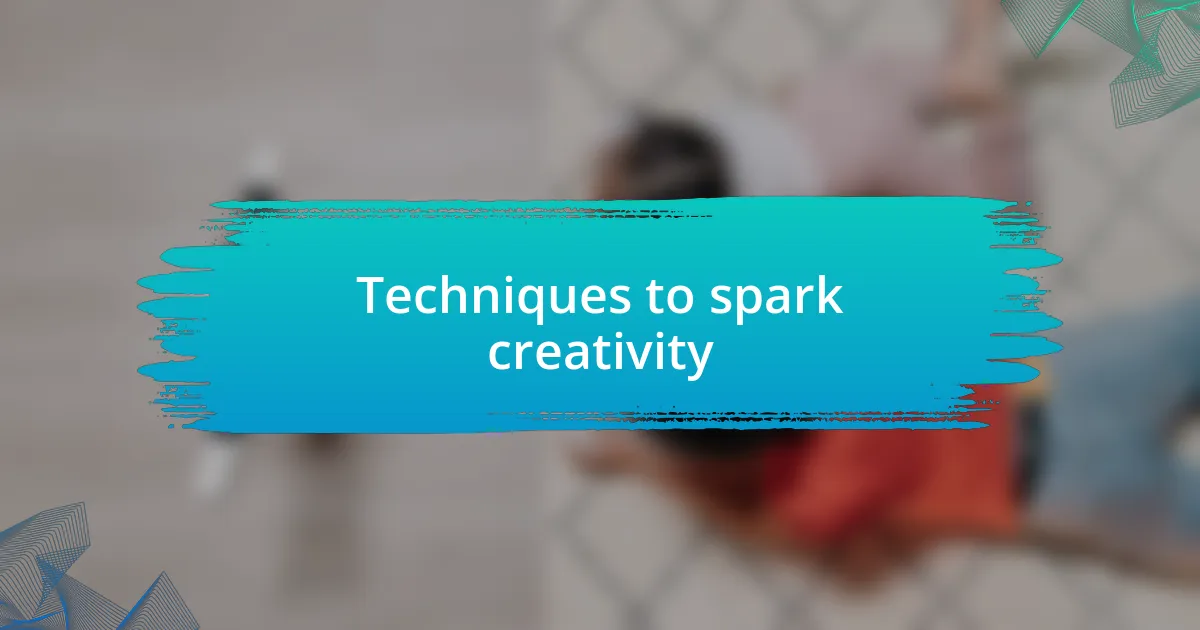
Techniques to spark creativity
Sometimes, a simple shift in routine can reignite your creative spark. I remember when I started taking daily walks in my neighborhood. The fresh air and change of scenery allowed my mind to wander freely, and I often found myself brainstorming ideas that I hadn’t considered before. It’s amazing how movement can clear mental clutter and make space for new thoughts.
Here are a few techniques that work well for sparking creativity:
- Change Your Environment: Rearranging your workspace or working in a new location can stimulate fresh ideas.
- Set Time for Freewriting: Allocate a few minutes daily to write whatever comes to mind—without judgment or structure.
- Engage with Different Art Forms: Attend a dance class or visit a gallery to inspire your own creativity through other mediums.
- Collaborate with Others: Sharing ideas with friends or colleagues can lead to unexpected insights and new directions.
- Limit Distractions: Turning off notifications and creating a focused space can help bring your attention to your creative process.
Embracing curiosity has also proved invaluable for me. There was a time when I explored photography as a hobby. Learning to see the world through a lens challenged me to observe details I previously overlooked, sparking imaginative concepts for my primary projects. This pursuit was more than just a break; it became a source of renewal for my creative well-being. Allowing yourself to explore different passions can open new pathways for inspiration, transforming how you approach your main work.
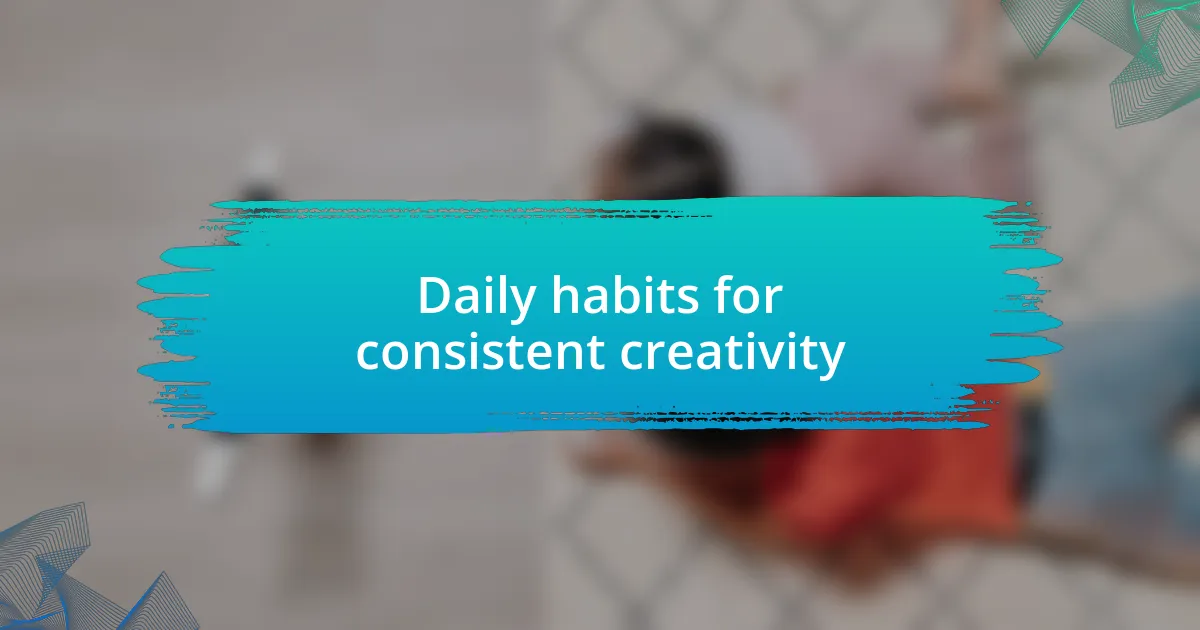
Daily habits for consistent creativity
Creating daily habits that nurture creativity is essential for maintaining a steady flow of ideas. For me, establishing a morning routine where I dedicate time for journaling has been a game-changer. There’s something about putting pen to paper in the quiet hours that sparks inspiration and reflects my thoughts without any filters, allowing my imagination to roam freely.
I’ve noticed that incorporating small rituals, like enjoying a cup of tea or coffee while listening to calming music, shifts my mindset. This simple act helps me transition into a creative space, almost like warming up before a workout. Have you ever found that certain sounds or flavors can transport you to a different mental landscape? It’s fascinating how sensory experiences can set the tone for creativity.
Another habit I find valuable is setting aside a specific time each day for creative exploration, even if it’s just 15 minutes. Whether it’s doodling ideas or sketching concepts, this practice has allowed me to step back from perfectionism, embracing the process instead. I often ask myself, “What if this is just for fun?” and this perspective really liberates my creative energy and leads to unexpected discoveries.
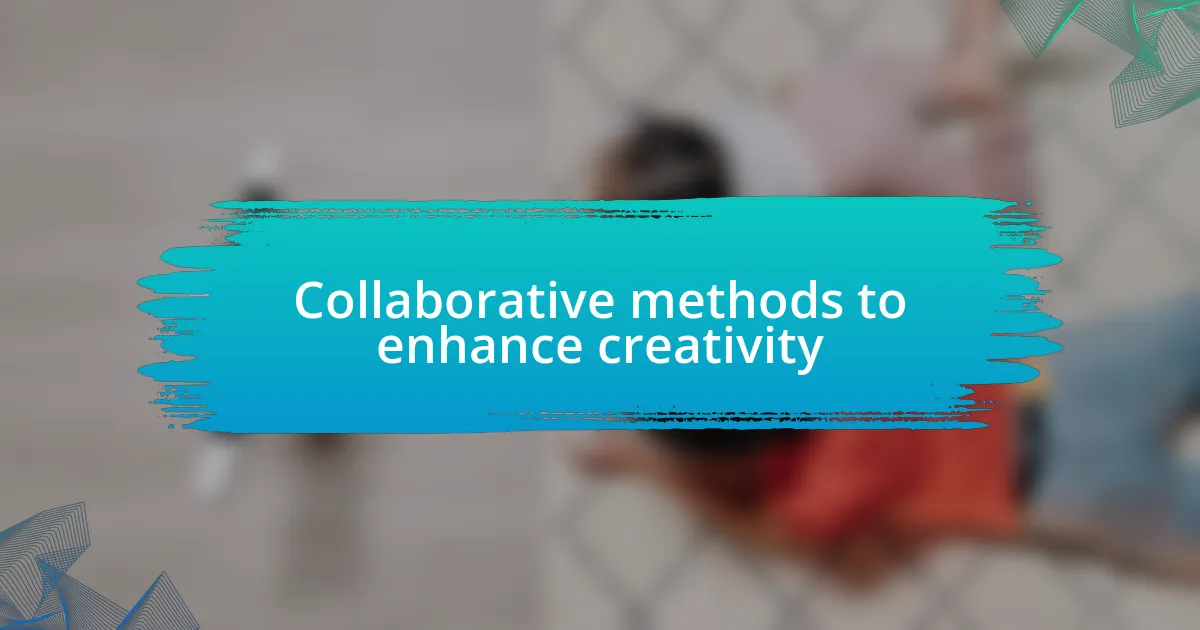
Collaborative methods to enhance creativity
Collaborative methods can significantly elevate your creative output, often providing fresh perspectives that we might miss alone. I remember one brainstorming session with a group of friends where we tossed around ideas without judgment. The environment was so relaxed that our wildest thoughts transformed into viable concepts, reminding me how vital it is to share and build on each other’s creativity. Have you tried bouncing your ideas off someone? The possibilities expand when you invite dialogue.
Another effective technique I’ve employed is participating in creative workshops. One time, I joined a writing group focused on storytelling. The feedback I received from fellow writers was invaluable; they pointed out nuances I had overlooked. It was there that I realized how collaboration not only sharpens your skills but also deepens your understanding of your own creative processes. When you share your work, you might find support that leads to breakthroughs.
Finally, I find that setting up regular feedback sessions can greatly enhance creative projects. In my experience, sharing drafts with peers allows me to gain insights that I wouldn’t have discovered on my own. It’s not just about critique; it’s about exploring new dimensions and refining ideas together. How often do you seek out constructive criticism? It’s a powerful tool that can turn a simple concept into something extraordinary.

